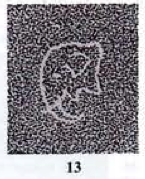+ Issue Date : 01/09/1867
+ Classification : Postage Stamp
+ Emission : Definitive / General Issue
+ Printer : De La Rue & Co, Limited
+ Printing : Typography
+ Paper : White Woven Paper
+ Watermark : Elephant's Head
+ Perforations : 14
+ Separations : Normal Perforations
+ Gum Type : Gum
+ Shape : Rectangular
+ Orientation : Vertical
Surcharged by De La Rue in different coloured inks to distinguish the various values because the 1 anna brown and 2 annas yellow were used to make three different “cents” values each.
CROWN COLONY
The Straits Settlements, a British colony of islands off the Malayan peninsula that included Singapore, used stamps from India between 1854 and 1867. When the Settlements became a crown colony in 1867, they began issuing their own stamps, not least because they adopted a currency based on 96 cents to a silver dollar.
On 1 September 1867, the Straits Settlements took charge of its own postal affairs, and issued a set of stamps to coincide with the occasion. Those times, a new issue did not mean a new design. In fact, a new issues were often just an administrative step in "up-dating", so to speak. So, the first Straits Settlements stamps were a set of Indian stamps overprinted with a crown and a value surcharge for "cents" - practical if not pretty.
Straits Settlements first adhesive stamps were issued beginning on 1 September 1867, nine types in the existing stocks of Indian stamps featuring a portrait of the young Queen Victoria, and the stamps were inscribed with a crown across the top and the "cents" denomination across the bottom.
A surcharge is an inscription on a stamp that alters its value, either an increase or decrease. Most stamps are printed with one surcharge, but the Straits Settlements stamps carried two - one for altering value and second to alter the currency.
This method was used as new designs and a new printing took a very long time. As it were, the Crown Agents took some time deciding between the alternatives before settling for the overprint a tthe top and surcharge value at the bottom design. This was a provisional issue and the stamps were only used briefly. For this reason, the quantities of each denomination overprinted and issued were small and these stamps are rather sought after by serious collectors. The reason that overprints were usually on the 1- and 2-anna stamps were probably because there were larger stocks of these available in India.
A variety of the 12 cents exists with a double overprint. This variety is known only in unused condition and was considered for some time as a trial overprint which found its way into the philatelic market.
WATERMARK


